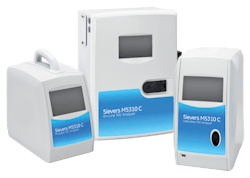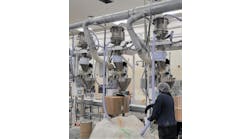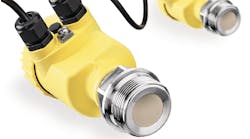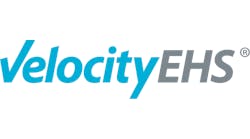Amanda Scott, product management leader, SUEZ -- Water Technologies & Solutions
One of the most commonly used compounds in the chemical industry is water – not only as a solvent in processing, but also as an energy carrier in the cooling or heating cycle. Monitoring water quality can predict performance and protect equipment.Chemical Processing spoke with Amanda Scott, product management leader for the Sievers* product line at SUEZ --Water Technologies & Solutions, we discovered how implementing critical control points, such as total organic carbon (TOC) analyzers for monitoring closed-loop cooling water systems, can help ensure efficiency and productivity.
Q: What particular issues should a plant check for in a closed-loop cooling water system?
A: Closed-loop cooling water systems offer many advantages — the chemistry can be precisely controlled and it's designed to be highly efficient. These systems are recognized by various regulatory agencies as the best available technology to minimize the impact on environmental life and water use. However, leaks can occur, and any unmonitored leaks can significantly impact performance, damage assets or even cause plant shutdowns. Proactively monitoring water quality can help mitigate risks, as well as prevent three critical issues: scale, corrosion and fouling.
Q: What issues can TOC analyzers detect?
A: TOC analyzers measure all organic compounds, and thus, all carbon contaminants. We know that some organics can oxidize to organic acids, such as acetic acid, and reveal harmful corrosive ions. For example, sulfonated or halogenated organics may not be harmful and can go undetected by ion sensors at room temperature. However, exposure to a boiler system's high temperatures and pressures can generate harmful chlorides and sulfates. If undetected, these compounds can accumulate over time, damaging pipe walls and equipment.
Traditional monitoring methods such as pH or conductivity might not be able to detect these chemicals before oxidation. TOC analyzers will rapidly detect ionic and nonionic organic contaminants to help prevent acid corrosion. TOC analyzers also monitor inorganic carbon (bicarbonates, carbonates and carbon dioxide). This helps plants correct the cation conductivity result from the presence of carbon dioxide. It’s necessary to monitor and remove carbonates to reduce scaling.
The presence of organics can affect a process in several ways. Source water organics, such as polysaccharides, humic acids or chlorinated organics from water treatment systems, can hinder treatment efficiency. Monitoring organic changes in the source water is critical to preventing membrane fouling, optimizing chemical dosage and maintaining acceptable water quality levels for boiler make-up water.
Organics can also be food for microbial growth. Instead of waiting to see if you have a biofouling problem, monitoring the organics can help eliminate this potential issue and prevent microbial growth from occurring. Furthermore, TOC data can be used to troubleshoot unknown issues. If the TOC remains constant, but an issue occurs, you can pinpoint it as an inorganic ingress. Using these tools can prevent catastrophic damage, higher operating costs or unplanned blowdowns that reduce productivity.
Q: Why are traditional monitoring techniques not as effective at spotting leaks like this?
A: With a closed-loop system, the chemistry is really important. When you’re using traditional tools like pH and conductivity, you might not be picking up all the key contaminants. pH tools can be overwhelmed by corrosion controlling chemicals and conductivity will obviously only detect ionic contaminants. Glycol has emerged as a difficult-to-detect compound that can have significant corrosive effects on a plant. For instance, at room temperature and pressure, glycol is difficult to detect especially at trace quantities. Furthermore, at higher temperatures and pressure, glycol breaks down and yields organic acids that can degrade plant equipment.
We’ve heard from several plants that even a 12-ounce leak can cause catastrophic damage and a plant might need to shut down. You need a tool that has superior sensitivity to quickly alert the operators if something’s wrong. TOC accurately recovers glycol at the concentration where it matters, often at µg/L levels.
Q: Are operators alerted right away?
A: With continuous online monitoring tools for organic carbon, operators can obtain results within minutes. As mentioned, TOC analysis yields complete oxidation and recovery of all organic compounds present in a sample. This can be used for establishing a baseline, detecting a change and reacting to the results. The sensitivity of TOC analyzers is a differentiating characteristic from other monitoring tools such as sensors.
Sievers M5310 C Analyzers are available in portable, laboratory and online configurations. Accurate, fast and reliable results for water-quality monitoring.
Results delivered by sensors are compared to a reference point, while analyzers detect the true amount of the contaminant that is present in the sample. Sensors may provide faster results, but often have less sensitivity, less accuracy and cannot typically be verified with check standards. Sensors need more frequent calibration due to interferences, but they tend to be lower capital costs. Analyzers will have a higher capital cost, but they prevent drift. It all depends on the amount of risk a plant is willing to take. A high risk would be no monitoring, a moderate risk would be sensors that could drift and a low-risk situation would be to use an analyzer as a critical control tool.
Q: What does an effective testing procedure entail?
A: The end goal is water-treatment optimization — the ability not only to apply the right chemistries and processes, but to monitor water quality. First, one needs to understand what the data will be used for. It can align with the need to understand the plant’s process, protect equipment or drive productivity. Identifying goals, setting limits and determining monitoring points will allow plants to validate process assumptions.
I have an example from a plant that began developing its process by examining its cooling-water loops. The plant tested condensate and condensate spiked with glycol. For this plant, it was important to detect glycol leaks. (Two of their sister plants had to shut down for several days because a glycol leak went undetected.)
Results revealed the contamination was caused by small glycol leaks entering the boiler feedwater pump in two possible ways, both involving faulty seals. The plant was able to identify where the problem was coming from, what tools to use and set limits. It was determined that condensate TOC should be about 200 µg/L. If a sample is over 200 µg/L, operators should analyze another sample to confirm, or switch to an alternate feedwater pump. Setting plant limits and developing actions based on data allows operators to react quickly to upsets.
Q: How does this monitoring help meet regulatory compliance?
A: From an external standpoint, guidelines exist for boiler feedwater quality. Some power organizations like EPRI recommend less than 100 parts per billion (ppb) or µg/L of TOC. While the VGB, European technical association for power and heat generation, recommends less than 200 ppb. The higher temperature and pressure systems require higher steam purity.
Internal guidelines might also exist from equipment manufacturers. The boiler itself or the turbine could require certain parameters to be met to ensure equipment integrity and reliability.
Q: How do the Sievers TOC analyzers differ from all their alternatives?
A: SUEZ offers a portfolio of TOC solutions tailored to specific monitoring needs from ultrapure to wastewater. For example, an analytical tool for ultrapure water must provide stable, sensitive results. Wastewater analyzers must be able to process complex matrices and particulates.
All TOC analyzers oxidize organics to carbon dioxide then measure the carbon dioxide. However, there are a variety of methods to oxidize and detect carbon dioxide.
For source water, boiler feedwater and condensate, SUEZ offers the Sievers M-series, a versatile and simple analyzer. These analyzers are easy to maintain, deliver maximum uptime and offer an operating range of 30 parts per trillion (ppt) to 50 parts per million (ppm) or mg/L. They’re available in laboratory, portable or online.
For complex streams with higher organic particulates and salts, Sievers offers the InnovOx family of TOC analyzers. Sievers InnovOx has a dynamic range of 50 ppb to 50,000 ppm and it can analyze samples with high temperatures, solids, dispersed oil and particulates of up to 800µm.
Q: Is there anything you’d like to add?
A: If you don't measure it, how can you control it? If plants spend time and money on systems for power generation, cooling and water treatment, it’s beneficial to put in critical control points to ensure those systems are efficient and productive.
For more information, visit: www.suezwatertechnologies.com/sievers
* Trademark of SUEZ, may be registered in one or more countries.





